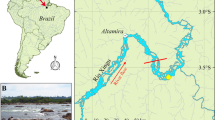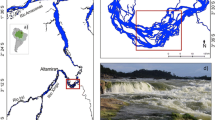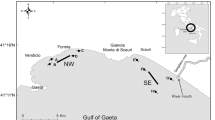Abstract
Studies on the trophic ecology of fish have revealed considerable alimentary plasticity for the majority of ichthyofauna in tropical rivers. This leads to the prediction that diet reflects the availability of food in the environment, namely seasonal variation in the abundance and type of food resources. To examine this, we assess: (1) seasonal variation in the diet and trophic structure of assemblages of benthic fish inhabiting the main channel of a large floodplain river in the Brazilian Amazon, (2) seasonal changes in the availability of food resources, (3) the trophic response (food selectivity) of benthic species in relation to food availability and (4) niche overlap among benthic species. Data were collected during 2 rising and 2 receding phases. Aquatic insects, plant matter and detritus were the predominant items in the diet of assemblages of benthic fish. The majority of fish species changed their diet between seasons. The diets of Exallodontus aguanai and Sternarchella calhamazon were studied in detail and showed positive correlation with food resource availability. Feeding selectivity varied among seasons for these two species. Niche overlap between these two species was observed during only one receding season. Our results reveal the importance of aquatic insects in the predominantly omnivorous diet of the benthic fish assemblages. Trophic plasticity was also evident, possibly because of the seasonal availability of food items. These results underline the role that organic matter derived from floodplains plays in this aquatic system which is characterised as having naturally low autochthonous productivity.




Similar content being viewed by others
References
Abelha MCF, Agostinho AA, Goulart E (2001) Plasticidade trófica em peixes de água doce. Acta Scientiarum 23:425–434
Abrams P (1980) Some comments on measuring niche overlap. Ecology 61:44–49
Albert JS (2001) Species diversity and phylogenetic systematics of American knifefishes (Gymnotiformes, Teleostei), vol 190. Miscellaneous Publications, Museum of Zoology, University of Michigan, Ann Arbor, pp 1–127
Andrade MC, Fitzgerald DB, Winemiller KO, Barbosa PS, Giarrizzo T (2019) Trophic niche segregation among herbivorous serrasalmids from rapids of the lower Xingu River, Brazilian Amazon. Hydrobiologia 829:265
Arrington DA, Winemiller KO (2003) Diel changeover in sandbank fish assemblages in a neotropical floodplain river. J Fish Biol 63:442–459
Barletta M, Blaber SJM (2007) Comparison of fish assemblages and guilds in tropical habitats of the Embley (Indo-West Pacific) and Caeté (western Atlantic) estuaries. Bull Mar Sci 80:647–680
Barthem RB, Goulding M (1997) The catfish connection: ecology, migration and conservation of Amazon predators. Columbia University Press, New York
Bayley PB, Petrere M Jr (1989) Amazon fisheries: assessment methods, current status and management options. In: Dodeg DP (ed) Proceedings of the large rives symposium. Canadian Special Publication of Fisheries and Aquatic Sciences 106, pp 385–398
Bowen SH (1984) Detritivory in neotropical fish communities. Environ Biol Fishes 9:137–144
Burgess WE (1989) An atlas of freshwater and marine catfishes: a preliminary survey of the Siluriformes. T.F.H Publications, Neptune City
Cella-Ribeiro A, Assakawa LF, Torrente-Vilara G, Zuanon J, Leite RG, Doria C, Duponchelle F (2015) Temporal and spatial distribution of young Brachyplatystoma spp. (Siluriformes: Pimelodidae) along the rapids stretch of the Madeira River (Brazil) before the construction of two hydroelectric dams. J Fish Biol 86:1429–1437
Claro L Jr, Ferreira E, Zuanon J, Araujo-Lima C (2004) O efeito da floresta alagada na alimentação de três espécies de peixes onívoros em lagos de várzea da Amazônia Central, Brasil. Acta Amazonica 34:133–137
Cox-Fernandes C (1997) Lateral migration of fishes in Amazon floodplains. Ecol Freshw Fish 6:36–44
Cox-Fernandes C, Podos J, Lundberg JG (2004) Amazonian ecology: tributaries enhance the diversity of electric fishes. Science 305:1960–1962
Crampton WGR (2007) Diversity and adaptation in deep-channel Neotropical electric fishes. In: Sebert P, Onyango DW, Kapoor BG (eds) Fish life in special environments. Science Publishers, New Hampshire, pp 283–339
Gaspar da Luz KD, Abujanra F, Agostinho AA, Gomes LC (2001) Caracterização trófica da ictiofauna de três lagoas da planície aluvial do alto rio Paraná, Brasil. Acta Scientiarum 23:401–407
Gerking SD (1994) Feeding ecology of fish. Academic Press, New York
Gotelli NJ, Ellison AM (2013) EcoSimR: null models for ecology, version 1.00. http://www.uvm.edu/~ngotelli/EcoSim/EcoSim.html. Accessed 15 Nov 2014
Goulding M (1980) The fishes and the forest: explorations in Amazonian natural history. University of California Press, Berkeley
Goulding M, Carvalho ML, Ferreira EG (1988) Rio Negro: rich life in poor water. SPB Academic Publishing, The Hague
Goulding M, Barthem R, Ferreira EG (2003) The Smithsonian atlas of the Amazon. Smithsonian Books, Washington DC
Hoeinghaus DJ, Winemiller KO, Birnbaum JS (2006) Local and regional determinants of stream fish assemblage structure: inference based on taxonomic vs. functional group. J Biogeogr 34:324–338
Junk WJ, Bayley PB, Sparks RE (1989) The flood pulse concept in river-floodplain systems. In: Dodge DP (ed) Proceedings of the international large river symposium. Canadian special publication of fisheries and aquatic sciences, vol 106, pp 110–127
Kacelnik A (1984) Central place foraging in starlings (Sturnus vulgaris). I. Patch residence time. J Anim Ecol 53:283–300
Kawakami E, Vazzoler G (1980) Método gráfico e estimativa de índice alimentar aplicado no estudo de alimentação de peixes. Braz J Oceanogr 29:205–207
Kie JC (1999) Optimal foraging and risk of predation: effects on behavior and social structure in ungulates. J Mammal 80:1114–1129
Lechowich M (1982) The sampling characteristics of electivity indices. Oecologia 52:22–30
Lowe-McConnell RH (1987) Ecological studies in tropical fish communities. Cambridge University Press, Cambridge
Lundberg JG, Lewis WM, Saunders JF, Mago-Leccia F (1987) A major food web component in the Orinoco River channel: evidence from planktivorous electric fishes. Science 237:81–83
MacArthur RH, Pianka ER (1966) On optimal use of a patchy environment. Am Nat 100:603–609
Margalef R (1986) Ecologia. Omega Ediciones, Barcelona
Marrero C (1987) Notas preliminares acerca de la historia natural de los peces del Bajo Llano. I. Comparacion de los habitos alimentarios de três especies de peces gymnotiformes en el Rio Apure (Edo Apure, Venezuela). Hydrobiol Trop 20:57–63
Montaña CG, Winemiller KO (2010) Local-scale habitat influences morphological diversity of species assemblages of cichlid fishes in a tropical floodplain river. Ecol Freshw Fish 19:216–227
Mortillaro JM, Pouilly M, Wach M, Freitas CEC, Abril G, Meziane T (2015) Trophic opportunism of central Amazon floodplain fish. Freshw Biol 60:1659–1670
Nelson JS (1994) Fishes of the world, 3rd edn. Wiley, New York
Peterson CC, Keppeler FW, Saenz DE, Bower LM, Winemiller KO (2017) Seasonal variation in fish trophic networks in two clear-water streams in the Central Llanos region, Venezuela. Neotrop Ichthyol 15:e160125
Pianka ER (1994) Evolutionary ecology. Harper Collins College, New York
R Core Team (2017) R: a language and environment for statistical computing. R Foundation for Statistical Computing, Vienna, Austria. https://www.r-project.org/. Accessed 15 Nov 2014
Röpke CP, Ferreira E, Zuanon J (2013) Seasonal changes in the use of feeding resources by fish in stands of aquatic macrophytes in an Amazonian floodplain, Brazil. Environ Biol Fishes 97:401–414
Sale P (1974) Overlap in resource use and interspecific competition. Oecologia 17:245–256
Sih A, Christensen B (2001) Optimal diet theory: when does it work, and when and why does it fail? Anim Behav 61:379–390
Stewart DJ, Ibarra M, Barriga-Salazar RE (2002) Comparison of deep-river and sandy-beach fish assemblages in the Napo River basin, eastern Ecuador. Copeia 2002:333–343
Thomé-Souza MJF, Chao NL (2004) Spatial and temporal variation of benthic fish assemblages during the extreme drought of 1997-98 (El Niño) in the midlle rio Negro, Amazônia, Brazil. Neotrop Ichthyol 2:127–136
Townsend CR (2003) Individual, population, community, and ecosystem consequences of a fish invader in New Zealand streams. Conserv Biol 17:38–47
Uieda VS, Motta RL (2007) Trophic organization and food web structure of southeastern Brazilian streams: a review. Acta Limnol Bras 19:15–30
Vannote R, Minshall GW, Cummins KW, Sedell JR, Cushing CE (1980) The river continuum concept. Can Spec Publ Fish Aquat Sci 37:130–137
Winemiller KO (1995) The structural and functional aspects of fish diversity. Bulletin Francais de la Peche et de la Pisciculture 337/338/339:23–45
Winemiller KO (1996) Factors driving temporal and spatial variation in aquatic floodplain food web. In: Polis GA, Winemiller KO (eds) Food webs: integration of patterns and dynamics. Kluwer Academic Publishers, Hingham, pp 298–312
Winemiller KO, Jepsen DB (1998) Effects of seasonality and fish movement on tropical river food webs. J Fish Biol 53:267–296
Winemiller KO, Kelso-Winemiller LC (1996) Comparative ecology of catfishes of the Upper Zambezi River floodplain. J Fish Biol 49:1043–1061
Winemiller KO, Pianka ER (1990) Organization in natural assemblages of desert lizards and tropical fishes. Ecol Monogr 60:27–55
Zaret TM, Rand AS (1971) Competition in tropical stream fishes: support for the competitive exclusion principle. Ecology 52:336–342
Acknowledgements
The authors are grateful to Instituto Piagaçu (IPi) for the financial and logistical support during the Peixes da Floresta Project (Programa Petrobrás Ambiental). C. Duarte and C. Deus acknowledge support from the Brazilian National Council for Scientific and Technological Development (CNPq Universal # 474421/2011-2) and Amazonas Research Funding Agency (FAPEAM Universal Amazonas # 021/2011). C. Duarte received Doctoral Sandwich Program Abroad (PDSE CAPES # 99999.003747/2014-00). A. Magurran acknowledges support from the European Research Council (ERC BioTIME # 250189) and the Royal Society. J. Zuanon received a productivity grant from the CNPq (# 313183/2014-7).
Author information
Authors and Affiliations
Corresponding author
Additional information
Publisher's Note
Springer Nature remains neutral with regard to jurisdictional claims in published maps and institutional affiliations.
Handling Editor: Telesphore Sime-Ngando.
Electronic supplementary material
Below is the link to the electronic supplementary material.
Rights and permissions
About this article
Cite this article
Duarte, C., Magurran, A.E., Zuanon, J. et al. Trophic ecology of benthic fish assemblages in a lowland river in the Brazilian Amazon. Aquat Ecol 53, 707–718 (2019). https://doi.org/10.1007/s10452-019-09720-5
Received:
Accepted:
Published:
Issue Date:
DOI: https://doi.org/10.1007/s10452-019-09720-5




